We are in the second decade of the third millennium. Artificial intelligence, cryptocurrencies, blockchain and self-driving cars are on the rise. Kurzweil is saying that computers will be smarter than us in 12 years. And you are mistaken if you think evolution is limited to computers. Facebook currently has 71 gender options available to its users. Several other social technologies are being created to deal with today’s world, which is undoubtedly VUCA (volatile, uncertain, complex and ambiguous).
Meanwhile, we continue to use organizational structures that have emerged a millennia ago in our companies. Yes, I’m talking about the fundamentally autocratic way of management. You do what your boss says. Power needs to be delegated from top to bottom, and so on. Some approaches have come up to try to propose a “rewriting” of this system, although there are just a few alternatives.
To deal with the side effects of the hierarchical structure and navigate the VUCA world, many experts propose the creation of contexts where self-organization is possible. This is the case of Steve Denning, who in his research realized that most high-performance teams are self-organized. Other evidence points to the same path, such as the Responsive Manifesto, Agile Software Development and Evolutionary Organizations.
In order to increase the range of social technologies for self-organization (and to address the “disadvantages” of other approaches), we (Target Teal + Partners) have developed a catalyst for self-organization called Organic Organization.
Organic Organization (O2)
O2 is currently composed of a set of essential rules, called Meta-Agreements, and an ever growing Pattern Library. It can be applied in a team, department or in an entire organization. The only rule is that the target group needs to have a considerable level of autonomy over the rest. Obviously, O2 will work at full power only when applied to the entire organization.
Nested Circle Structure
Like Holacracy and Sociocracy 3.0, O2 divides the organization into semiautonomous circles. These circles contain roles that perform some specific activities and share a common purpose. In general, old areas, departments, and teams form circles. However, O2 gives preference to small groups, with up to 12 members. External and internal circles are connected through special roles, called Outer and Inner Links.
5 basic modes
In our journey helping other teams and companies to develop self-organization, we have learned that it’s important to work on some “basic modes” to keep the group healthy in the long run. These modes aim to review the work, synchronize efforts, adapt the structure, select people who will maintain the process and take care of the relationships among members. These modes are developed in meetings governed by a facilitator chosen by the circle members.
Review
It’s amazing how many groups don’t gather to review their own work. Some do this individually or through revisions between boss and subordinate. But there is a better way.
When we are immersed in an environment where others see what we are doing, an effect called peer pressure emerges. In this context, we are much more attentive to the expectations of colleagues and we do our best to meet them. Research shows that this motivator is more powerful than money. Obviously, peer pressure creates “tensions” that make individuals in a group move towards the larger goal. The review mode helps to strengthen this environment.
It’s also common to hear managers complaining that their subordinates do nothing to improve the indicators. The problem is that you can’t worry about something you don’t see or can’t understand. It’s necessary to exercise the act of reviewing.
In O2, the way the review happens is defined by the facilitator. The most common format is to check actions, projects, metrics, and checklists assigned to the roles in the circle.
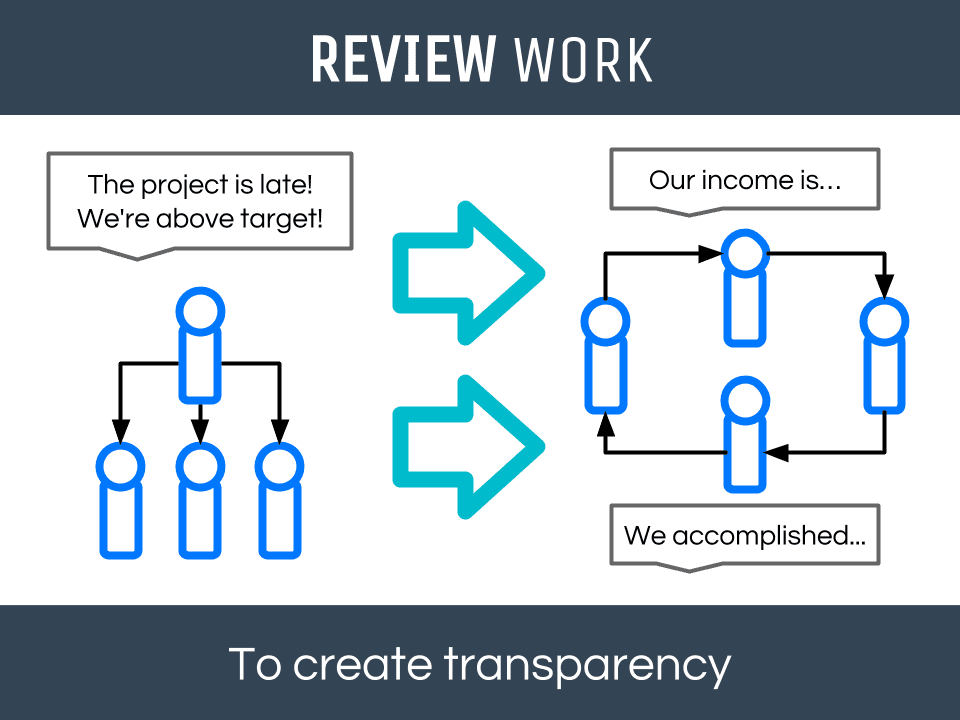
Synchronize
Many groups don’t develop effective mechanisms for making requests. And things get worse when the leader/manager centralizes the monopoly of the distribution of tasks, that is, when a person only performs tasks passed directly by his superior. Needless to say, this isn’t effective at all.
It’s not necessarily a matter of bad intention on the part of those who only do what the boss asks. Often the expectations, accountabilities and authorities aren’t clear. That is why in O2 all expectations have to be contracted through explicit roles.
Once you know what you can expect from your peers, it becomes easier to make requests. As with any organization, such requests for new projects, actions or information may be made at any time by any person. But through the synchronize mode, we ensure that this occurs with a minimum frequency in each circle.
O2 seeks to decentralize the distribution of projects and actions, to give more agility to groups or organizations.
The synchronize mode starts with building a list of perceived tensions, which are issues/problems/opportunities that demand something. These tensions are then treated one by one and processed into projects and actions that are assigned to the roles of the circle.
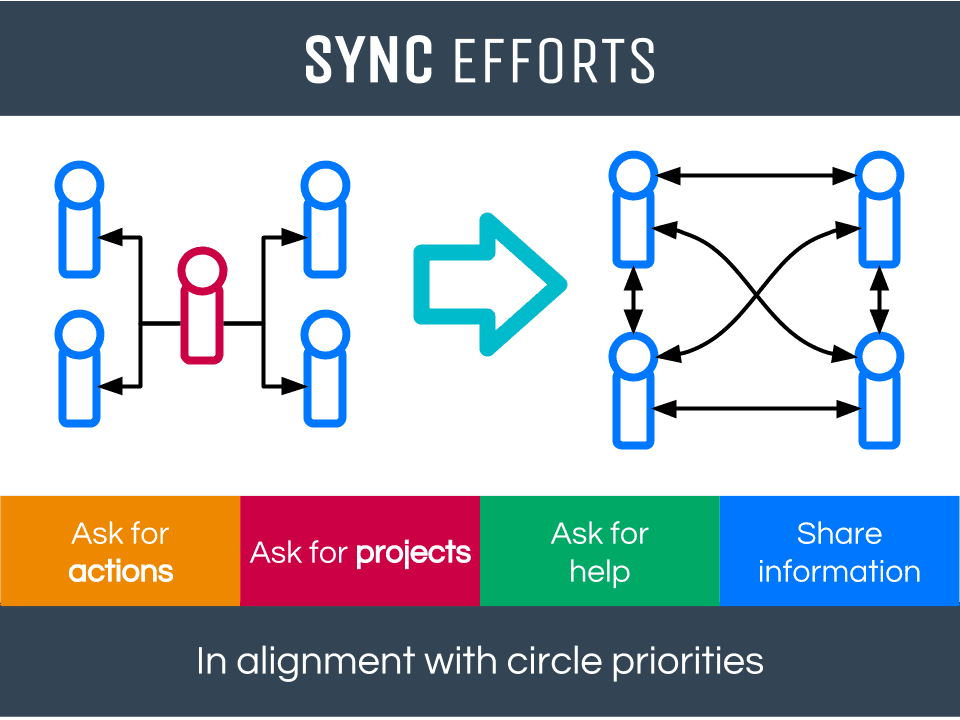
Adapt
We always design our organizations and teams with great affection. However, a designer, no matter how clever and dedicated, will never be able to predict everything that can happen (remember the VUCA world). The key is to create an evolutionary design, that is, a system with adaptability built in.
The organizational structure behind O2 makes use of this concept. Hence every expectation, role, and restriction within the O2 group or organization must be explicit. As new tensions and opportunities for improvement arise, the group adapts its structure to deal with the new context in which it is immersed.
All these changes happen exclusively in the adapt mode of each circle. At this point, groups can change roles, create inner circles, or set up restrictions that affect their members.
Explicit authority, that is, the clarity of what each member of the group “can” and “can’t” do allows for quick decision making and less hesitation on a daily basis.
The process for making these changes ensures that they are made only in alignment with the purpose of the circle. For example, a person cannot change a role for his or her own benefit, without this contributing in any way to the purpose of the circle.
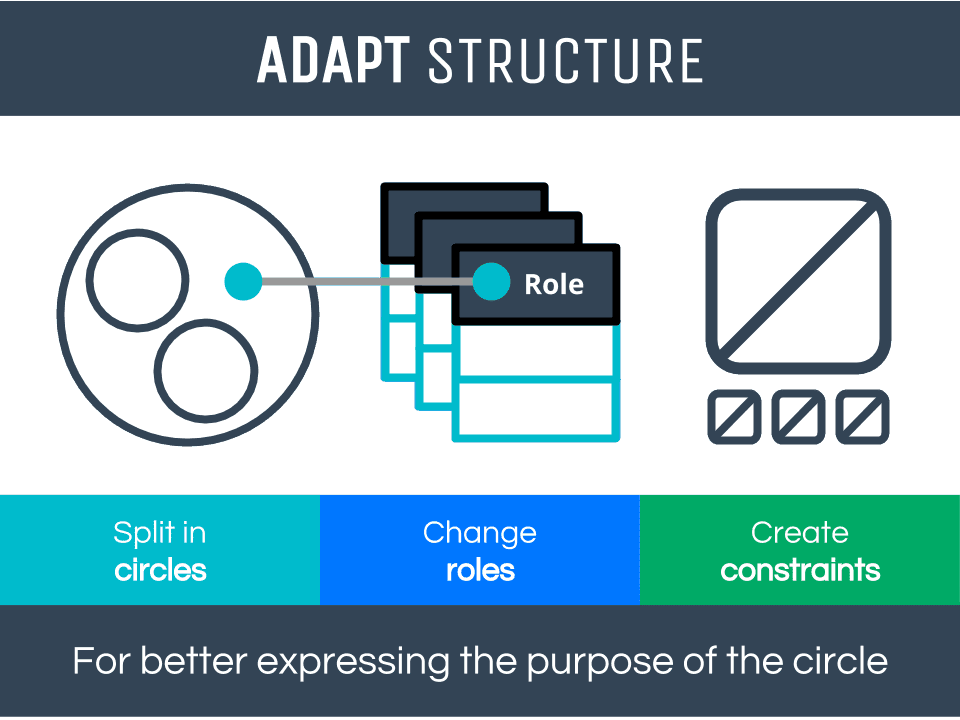
Select
Keeping groups in self-organization requires energy. Each circle in O2 contains some basic roles that ensure the method works. Three of these roles are chosen by the group itself through an election in the select mode: facilitator, secretary, and internal link.
The group performs “selection” on a regular basis (every 3 months, for example). Rotations in these core roles are recommended to empower most people in O2 and ensure independence from facilitators or outside experts.
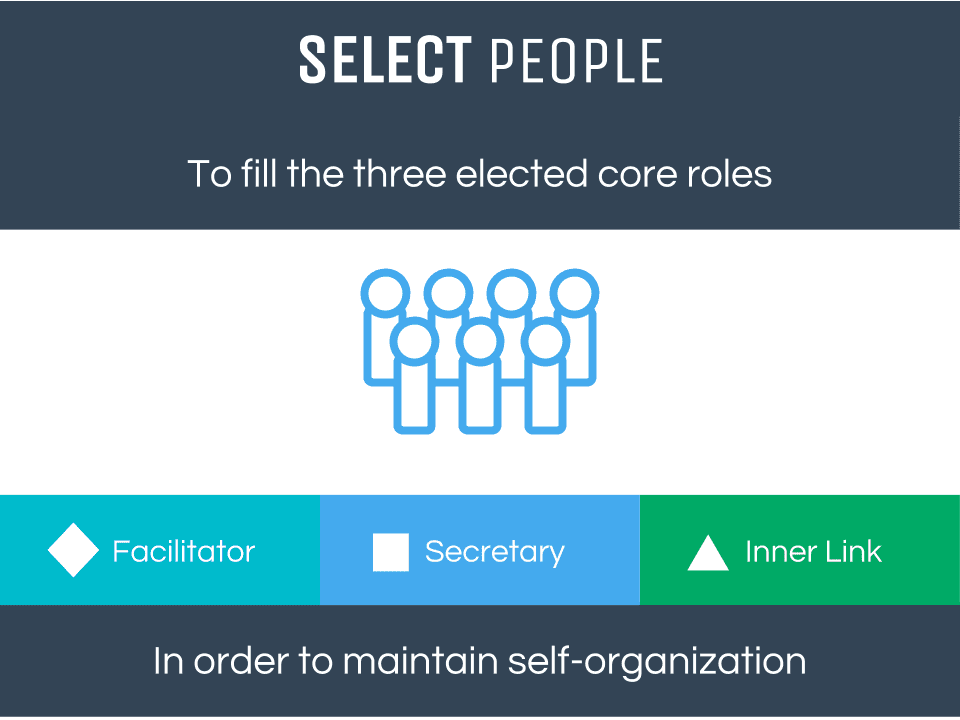
Care
The separation between work and personal life began with the conformist organizations (read here to understand better). The traditional corporate environment doesn’t welcome people entirely. The emotions, the uncertainties and the fears you leave at home. At work you need to be a “good professional”.
It turns out that in the 21st century work is predominantly creative (if yours is not, you might be replaced by a robot soon). And this type of activity, because it has greater interdependence between people and roles, requires more effective communication between agents. To navigate this complexity, you need to develop better relationships and emotional intelligence.
We understand that working the organizational space (structure, roles, restrictions, processes) isn’t enough for organizations. The care mode aims to develop communication, recognize individual needs and nurture openness among members, but without “polluting” the space of the organization.
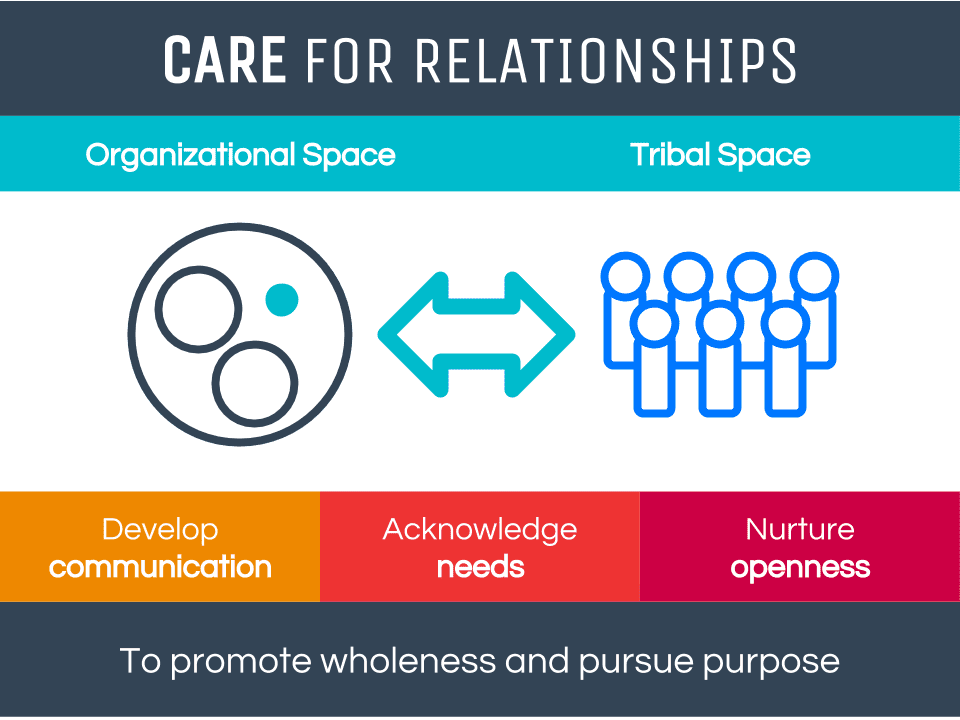
A mutual commitment
Playing O2 requires a mutual commitment between the participants. Everyone involved must abide by the rules outlined in the Meta-Agreements, regardless of roles and positions. This commitment includes the suspension of any prior authority systems or status differences. This means that in O2 the only sources of expectations, restrictions, and accountabilities are those defined by the group in circle meetings. We’ll cover this in more detail also in the next post.


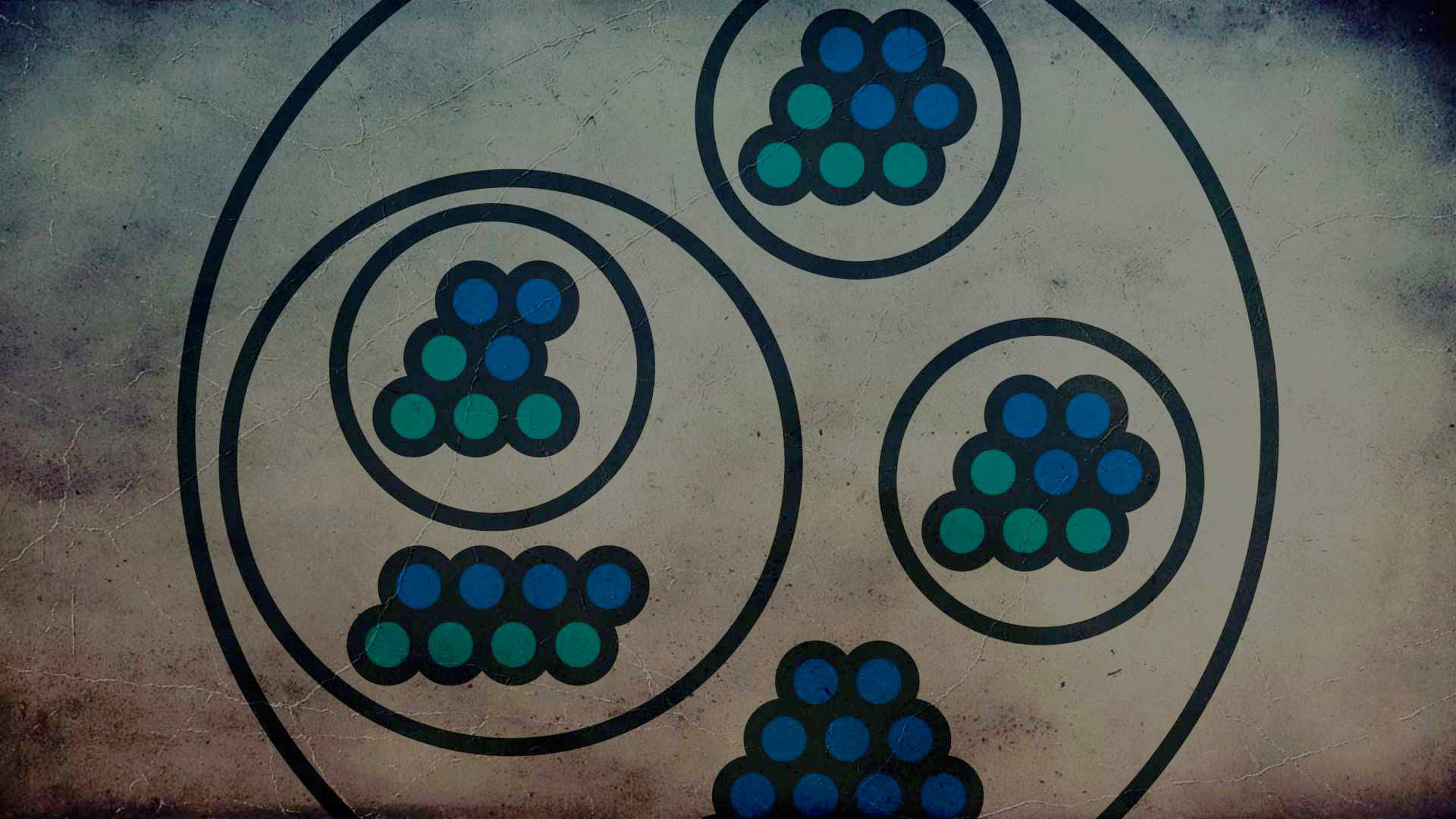
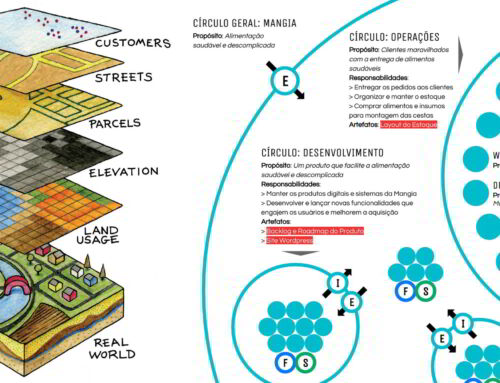


[…] our workshops or when we propose the O2 Catalyst we do not present a miraculous solution in the form of a revolutionary system that is suitable for […]
[…] we begin a series of posts where we will explain in more detail various elements that are part of Organic Organization, a self-management framework that we use at Target Teal. We will begin by talking about roles and circles, which are the basic building blocks of […]
[…] the heart of O2 is self-organization. We know that distributing authority and allowing a group to self-manage is […]
Thanks for sharing such an informative article. An organizational chart is important to make planning easier and defining the organizational structure, culture and style while showing clearly the line of authority and of responsibility
[…] environment we have a bunch of people unaware of their habits and how these can turn into anti-patterns and impair the effectiveness of the organization as a whole. What was once a good practice is now a […]
Great Read! and find this article much useful.